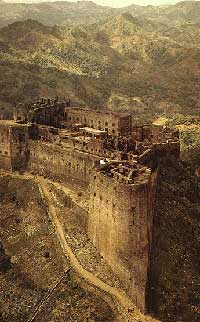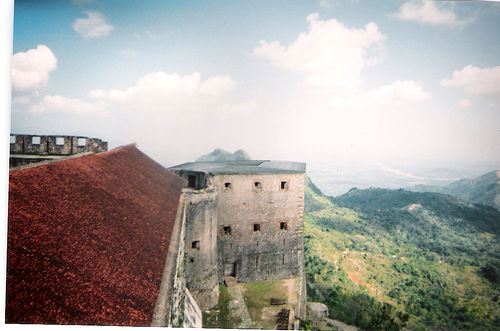|
La Citadelle LaFerrière |
|
 |
 |
| La Citadelle is considered one of the eight wonders of the world. Built by Henri Christophe, it is the largest fortress in the Caribbean. It was built to defend the northern part of the island from European invasion. This mammoth structure has walls measuring 46 feet thick and is large enough to hold 10,000 people; it was constructed over the course of 15 years. | |
| (From Wikipedia.org)
The Citadelle LaFerrière is a large mountaintop fortress located in northern Haiti, approximately 17 miles south of the city of Cap-Haïtien and five miles uphill from the town of Milot. It is the largest fortress in the western hemisphere. The massive stone structure was built by up to 20,000 slaves between 1805 and 1820 as part of a system of fortifications designed to keep the newly-independent nation of Haiti safe from French incursions. The Citadelle LaFerrière was built several miles inland, and atop the 3,000ft. Bonnet a L’Eveque mountain, in order to deter attack and to provide a lookout into numerous nearby valleys. It is possible to view Cap-Haïtien and the adjoining Caribbean Sea from the roof of the fortress. Anecdotally, it is possible to sight the eastern coast of Cuba, some 90 miles to the west, on clear days. The fortress was outfitted with 365 cannons of varying size, and enormous stockpiles of cannonballs still sit in pyramidal stacks at the fortress's base. Since its construction, the fortress has withstood numerous earthquakes, though it was never assaulted by French forces. The fortress was initially commissioned in 1805 by the self-proclaimed King of northern Haiti, Henri Christophe. At the time, Christophe was a general in the Haitian army and was the chief administrator of the country's northern regions. In 1806, along with co-conspirator Alexandre Pétion, Christophe launched a coup against Haiti's emperor Jean-Jacques Dessalines. Dessalines's death led to a power struggle between Christophe and Pétion, and ended with the division of Haiti into northern and southern compartments, with the north under Christophe's presidency by 1807. He later declared himself king in 1811. The volatile political situation gave Christophe further impetus to construct an unassailable fortress, and led to the widespread impressment of slaves into the construction process. Many slaves perished as a result. In the event of an invasion, Christophe instructed his military to burn the valuable crops and food stocks along the coast, then retreat to the fortress, setting ambushes along the sole mountain path which leads to the Citadelle. After Christophe's suicide in 1820 following a stroke, and mutiny of his troops, his body was entombed in limestone and placed in one of the Citadelle's interior courtyards. The encasement was done by partisans loyal to Christophe, to prevent the mutiliation of his corpse. The colossal physical dimensions of the fortress have made it into a Haitian national symbol, featured on tourist ministry posters as well as currency and stamps. The walls of the fortress itself rise up 130 feet from the mountaintop, and the entire complex, including cannonball stocks, covers an area of 108,000 square feet. The large foundation stones of the fortress were laid directly into the stone of the mountaintop and fastened using a mortar mixture which included limestone, molasses, and the blood of local cows and goats. Large cisterns and storehouses in the fortress's interior were designed to store enough food and water for 5,000 defenders for up to one year. The fortress included palace quarters for the king and his family, in the event that they needed to take refuge within its walls. Other facilities included dungeons, bathing quarters, and bakery ovens. The Citadelle's appearance from the trail leading up to its base has been likened to the prow of a great stone ship, jutting out from the mountainside. The structure is angular, and assumes different geometric forms based on the viewer's orientation. Though most of the fortress has no roof as such (the interior top is a latticework of stone walkways), some slanted portions are adorned with bright red tiles. The fortress has been repaired and refurbished several times since its construction, though little of it has been replaced, and its design remains the same. |
|